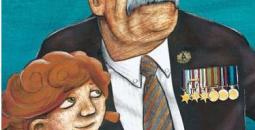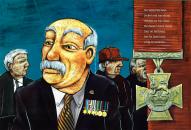AustLit
Latest Issues
AbstractHistoryArchive Description
Publication Details of Only Known VersionEarliest 2 Known Versions of
Works about this Work
-
And the Band Played Waltzing Matilda : Australian Picture Books (1999–2016) and the First World War
2019
single work
criticism
— Appears in: Children's Literature in Education , vol. 50 no. 2 2019; (p. 91-109)'Over the past two decades children’s picture books dealing with the Australian experience during the First World War have sought to balance a number of thematic imperatives. The increasingly sentimentalised construct of the Australian soldier as a victim of trauma, the challenge of providing a moral lesson that reflects both modern ideological assumptions and the historical record, and the traditional use of Australian war literature as an exercise in nation building have all exerted an influence on the literary output of a range of authors and illustrators. The number of publications over this period is proof of the enduring fascination with war as a topic as well as the widespread acceptance that this conflict has been profoundly significant in shaping Australian public and political culture and perceptions about national character and identity (Beaumont, 1995, p. xvii). As MacCallum-Stewart (2007, p. 177) argues, authors and illustrators must therefore balance notions of ‘respect’ for a national foundation myth with a ‘pity of war’ approach that reflects modern attitudes to conflict. Whatever their ideological commitment, many authors and illustrators respond to this challenge by adopting an approach that serves to indoctrinate readers into the Anzac tradition (Anzac refers to the Australian and New Zealand Army Corps raised for war in 1914. It has become a generic term for Australian and New Zealand soldiers. The Anzac tradition established at Gallipoli, Australia’s first major military campaign, has been traditionally viewed as the nation’s founding.'
Source: Publication blurb.
-
Remembering the Past through Picture Books
2014
single work
criticism
— Appears in: Picture Books and Beyond 2014; (p. 12-24)In anticipation of the commemorations around the centenary of World War 1 (2014-2018) this chapter examines the ways in which war and its effects have been represented in picture books for children. It looks at the ways in which these picture books create “textual monuments” as points of reference through which younger generations can “develop a narrative of the past” and “explore different points of view”.
-
Ruins or Foundations : Great War Literature in the Australian Curriculum
2012
single work
criticism
— Appears in: JASAL , vol. 12 no. 1 2012; 'The Great War has been represented in Australian curricula since 1914, in texts with tones ranging from bellicose patriotism to idealistic pacifism. Australian curricula have included war literature as one way of transmitting cultural values, values that continue to evolve as successive generations relate differently to war and peace. Changes in ethical perspectives and popular feeling have guided text selection and pedagogy, so that texts which were once accepted as foundational to Australian society seem, at later times, to document civilisation's ruin.
In recent years, overseas texts have been preferred above Australian examples as mediators of the Great War, an event still held by many to be of essential importance to Australia. This paper first considers arguments for including Great War texts on the national curriculum, exploring what war literature can, and cannot, be expected to bring to the program. Interrogating the purpose/s of war literature in the curriculum and the ways in which the texts may be used to meet such expectations, the paper then discusses styles of war texts and investigates whether there is a case for including more texts by Australian authors.' (Author's abstract)
-
Undercover for War Experiences
2006
single work
review
— Appears in: The Courier-Mail , 8 - 9 April 2006; (p. 26)
— Review of My Grandad Marches on Anzac Day 2006 single work picture book -
Untitled
2006
single work
review
— Appears in: Magpies : Talking About Books for Children , May vol. 21 no. 2 2006; (p. 32)
— Review of My Grandad Marches on Anzac Day 2006 single work picture book
-
The State of the Art
2006
single work
review
— Appears in: Australian Book Review , April no. 280 2006; (p. 56-58)
— Review of Annie's Chair 2005 single work picture book ; Brian Banana Duck Sunshine Yellow 2006 single work picture book ; A Monster Wrote Me a Letter 2005 single work picture book ; In the Bush : Our Holiday at Wombat Flat 2005 single work picture book ; The Year of the Mean Queen 2003 single work picture book ; Max Meets a Monster 2005 single work picture book ; My Grandad Marches on Anzac Day 2006 single work picture book ; Antarctic Dad 2006 single work picture book ; Hop Little Hare 2005 single work picture book -
Off the Shelf
2006
single work
review
— Appears in: The Age , 22 April 2006; (p. 28)
— Review of My Grandad Marches on Anzac Day 2006 single work picture book -
This Week's Selections
2006
single work
review
— Appears in: The Advertiser , 22 April 2006; (p. 10)
— Review of My Grandad Marches on Anzac Day 2006 single work picture book -
Untitled
2006
single work
review
— Appears in: Reading Time : The Journal of the Children's Book Council of Australia , August vol. 50 no. 3 2006; (p. 24)
— Review of My Grandad Marches on Anzac Day 2006 single work picture book -
Untitled
2006
single work
review
— Appears in: Magpies : Talking About Books for Children , May vol. 21 no. 2 2006; (p. 32)
— Review of My Grandad Marches on Anzac Day 2006 single work picture book -
Ruins or Foundations : Great War Literature in the Australian Curriculum
2012
single work
criticism
— Appears in: JASAL , vol. 12 no. 1 2012; 'The Great War has been represented in Australian curricula since 1914, in texts with tones ranging from bellicose patriotism to idealistic pacifism. Australian curricula have included war literature as one way of transmitting cultural values, values that continue to evolve as successive generations relate differently to war and peace. Changes in ethical perspectives and popular feeling have guided text selection and pedagogy, so that texts which were once accepted as foundational to Australian society seem, at later times, to document civilisation's ruin.
In recent years, overseas texts have been preferred above Australian examples as mediators of the Great War, an event still held by many to be of essential importance to Australia. This paper first considers arguments for including Great War texts on the national curriculum, exploring what war literature can, and cannot, be expected to bring to the program. Interrogating the purpose/s of war literature in the curriculum and the ways in which the texts may be used to meet such expectations, the paper then discusses styles of war texts and investigates whether there is a case for including more texts by Australian authors.' (Author's abstract)
-
Remembering the Past through Picture Books
2014
single work
criticism
— Appears in: Picture Books and Beyond 2014; (p. 12-24)In anticipation of the commemorations around the centenary of World War 1 (2014-2018) this chapter examines the ways in which war and its effects have been represented in picture books for children. It looks at the ways in which these picture books create “textual monuments” as points of reference through which younger generations can “develop a narrative of the past” and “explore different points of view”.
-
And the Band Played Waltzing Matilda : Australian Picture Books (1999–2016) and the First World War
2019
single work
criticism
— Appears in: Children's Literature in Education , vol. 50 no. 2 2019; (p. 91-109)'Over the past two decades children’s picture books dealing with the Australian experience during the First World War have sought to balance a number of thematic imperatives. The increasingly sentimentalised construct of the Australian soldier as a victim of trauma, the challenge of providing a moral lesson that reflects both modern ideological assumptions and the historical record, and the traditional use of Australian war literature as an exercise in nation building have all exerted an influence on the literary output of a range of authors and illustrators. The number of publications over this period is proof of the enduring fascination with war as a topic as well as the widespread acceptance that this conflict has been profoundly significant in shaping Australian public and political culture and perceptions about national character and identity (Beaumont, 1995, p. xvii). As MacCallum-Stewart (2007, p. 177) argues, authors and illustrators must therefore balance notions of ‘respect’ for a national foundation myth with a ‘pity of war’ approach that reflects modern attitudes to conflict. Whatever their ideological commitment, many authors and illustrators respond to this challenge by adopting an approach that serves to indoctrinate readers into the Anzac tradition (Anzac refers to the Australian and New Zealand Army Corps raised for war in 1914. It has become a generic term for Australian and New Zealand soldiers. The Anzac tradition established at Gallipoli, Australia’s first major military campaign, has been traditionally viewed as the nation’s founding.'
Source: Publication blurb.







